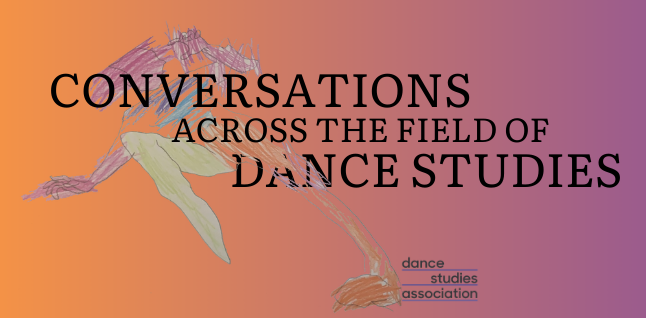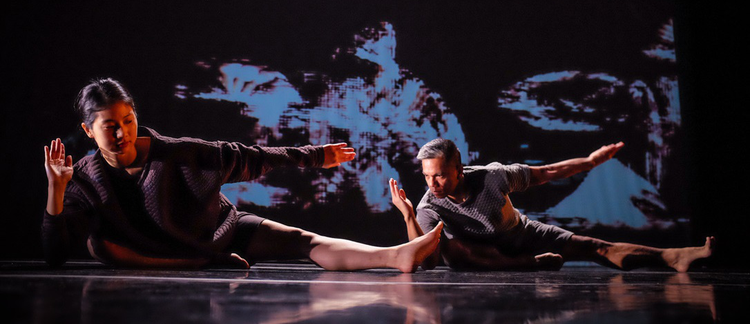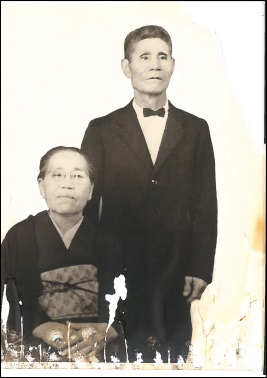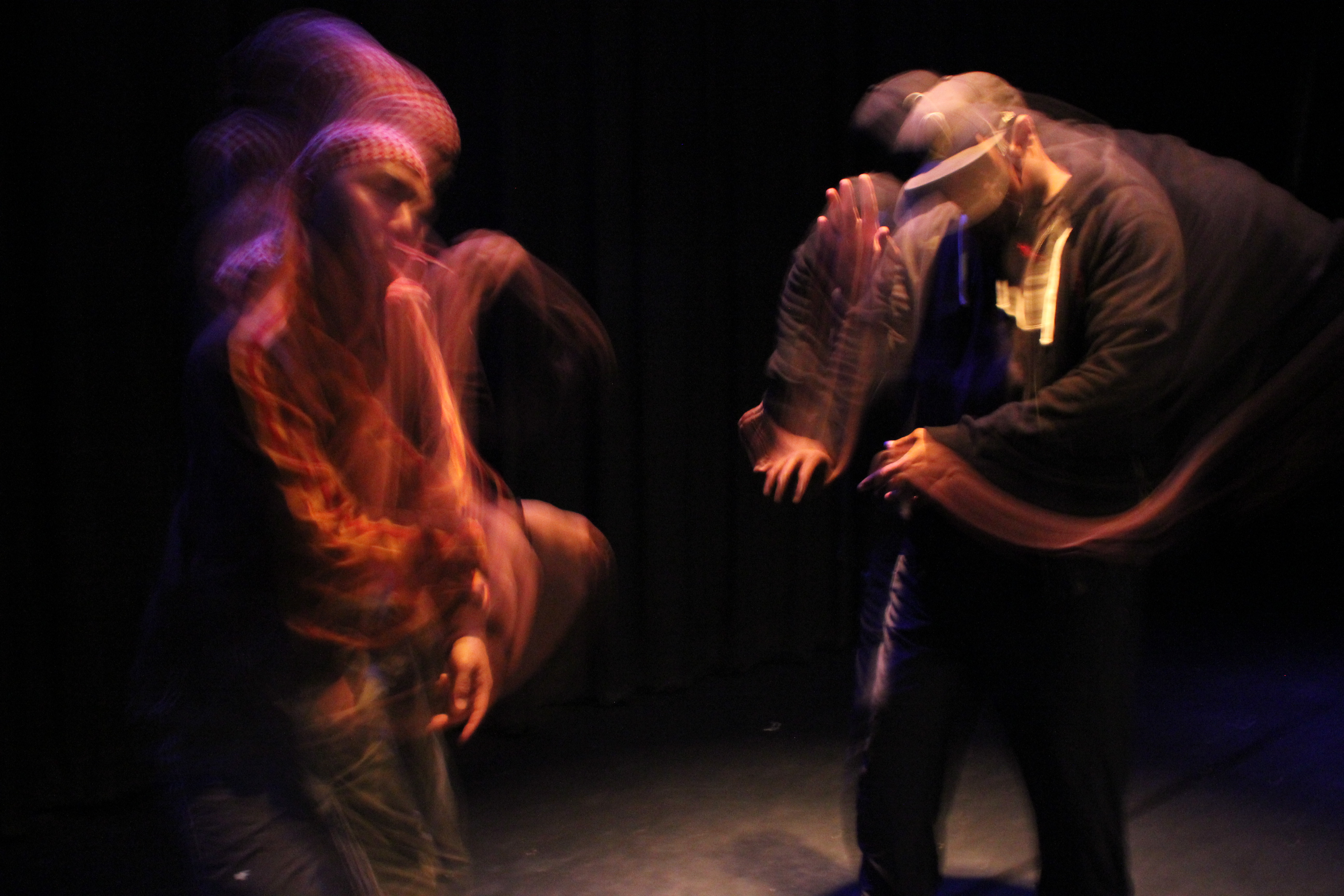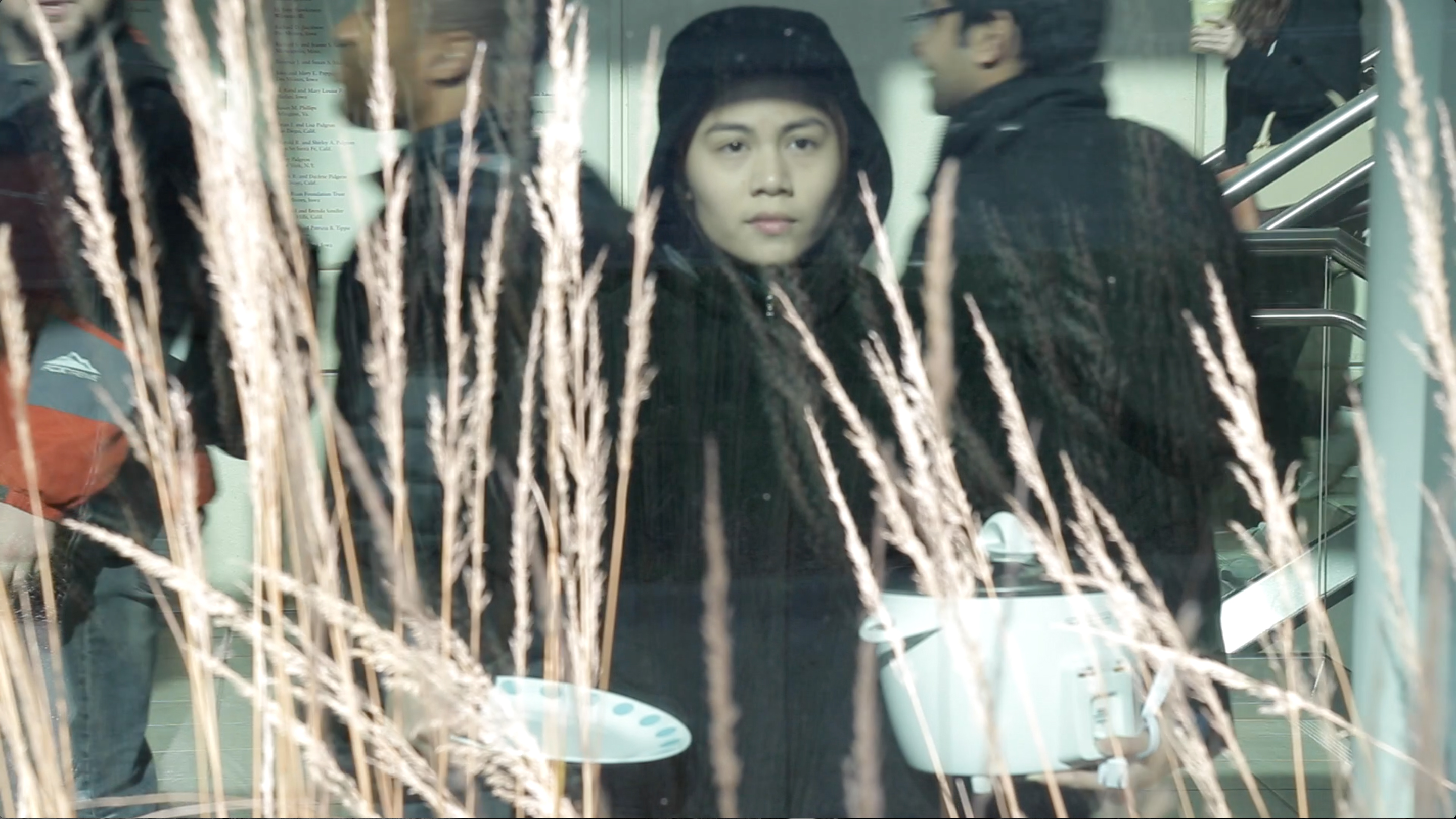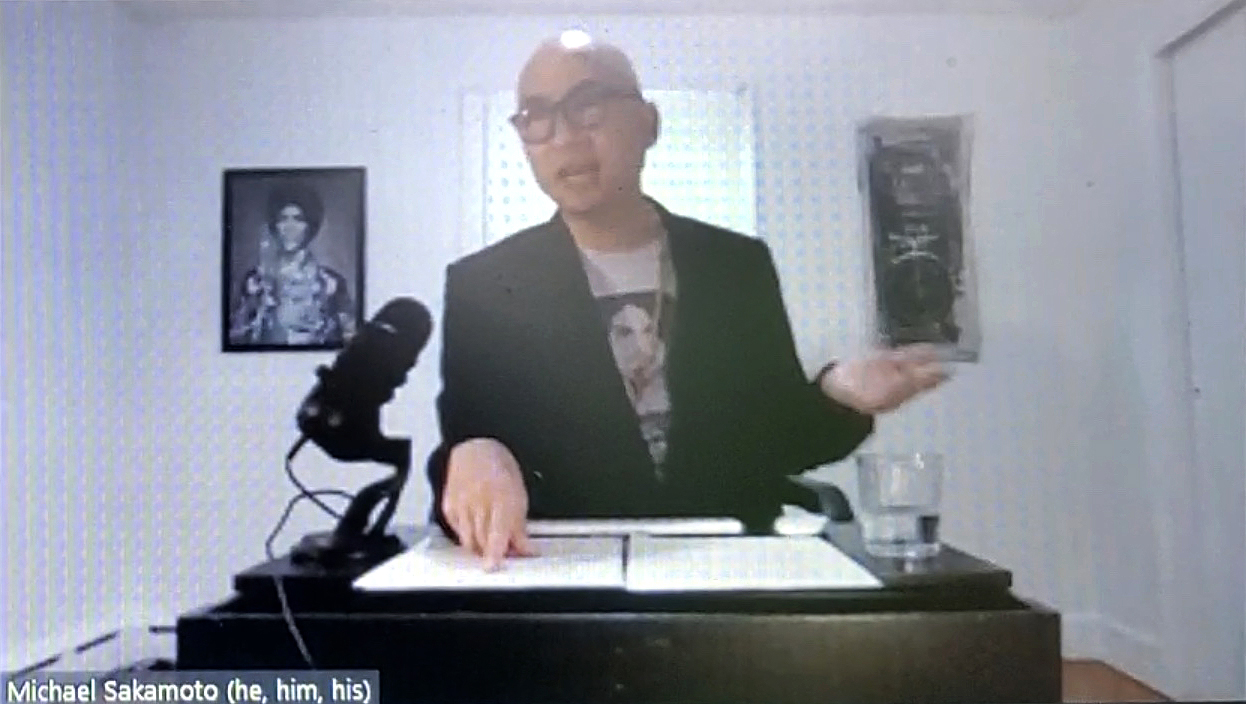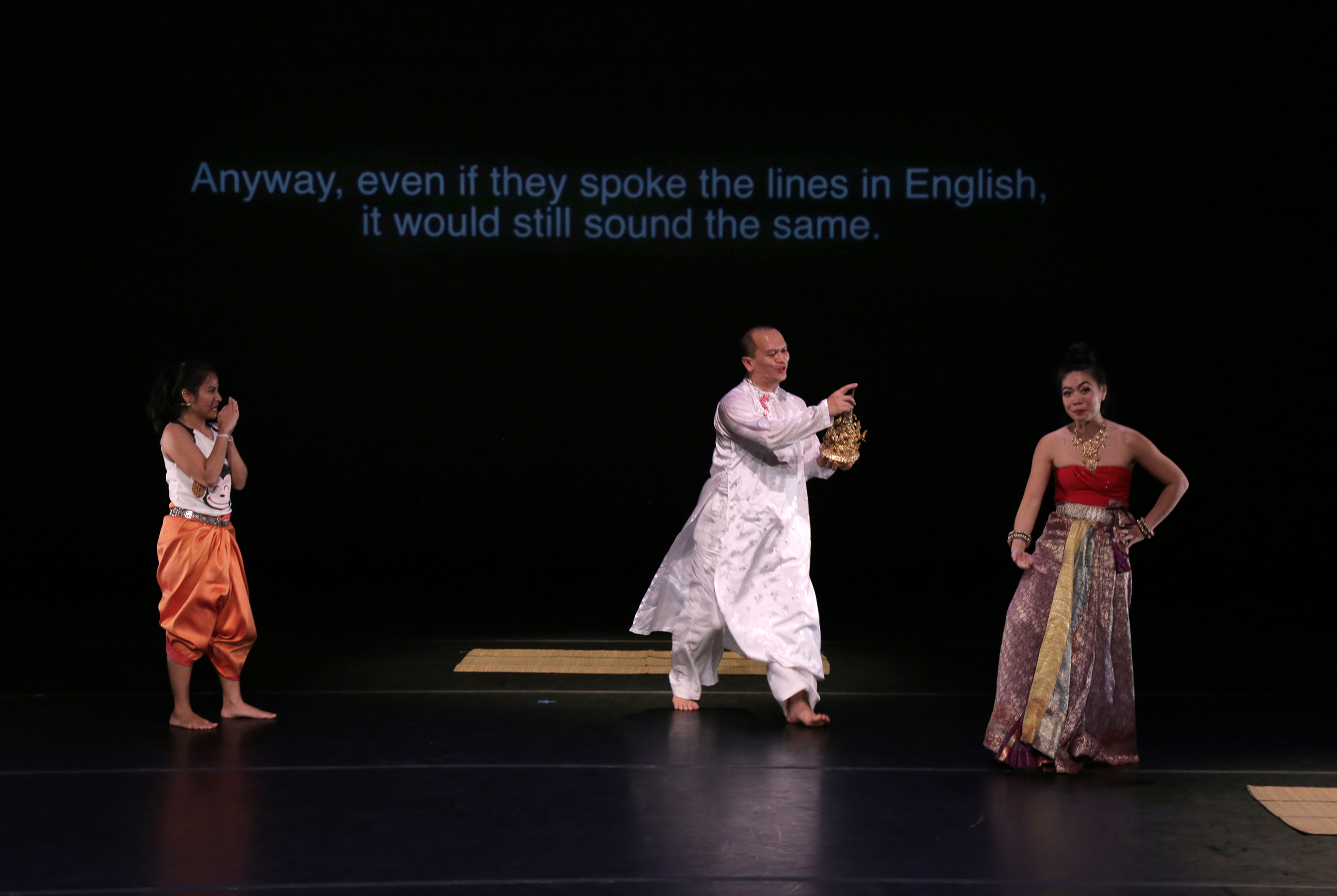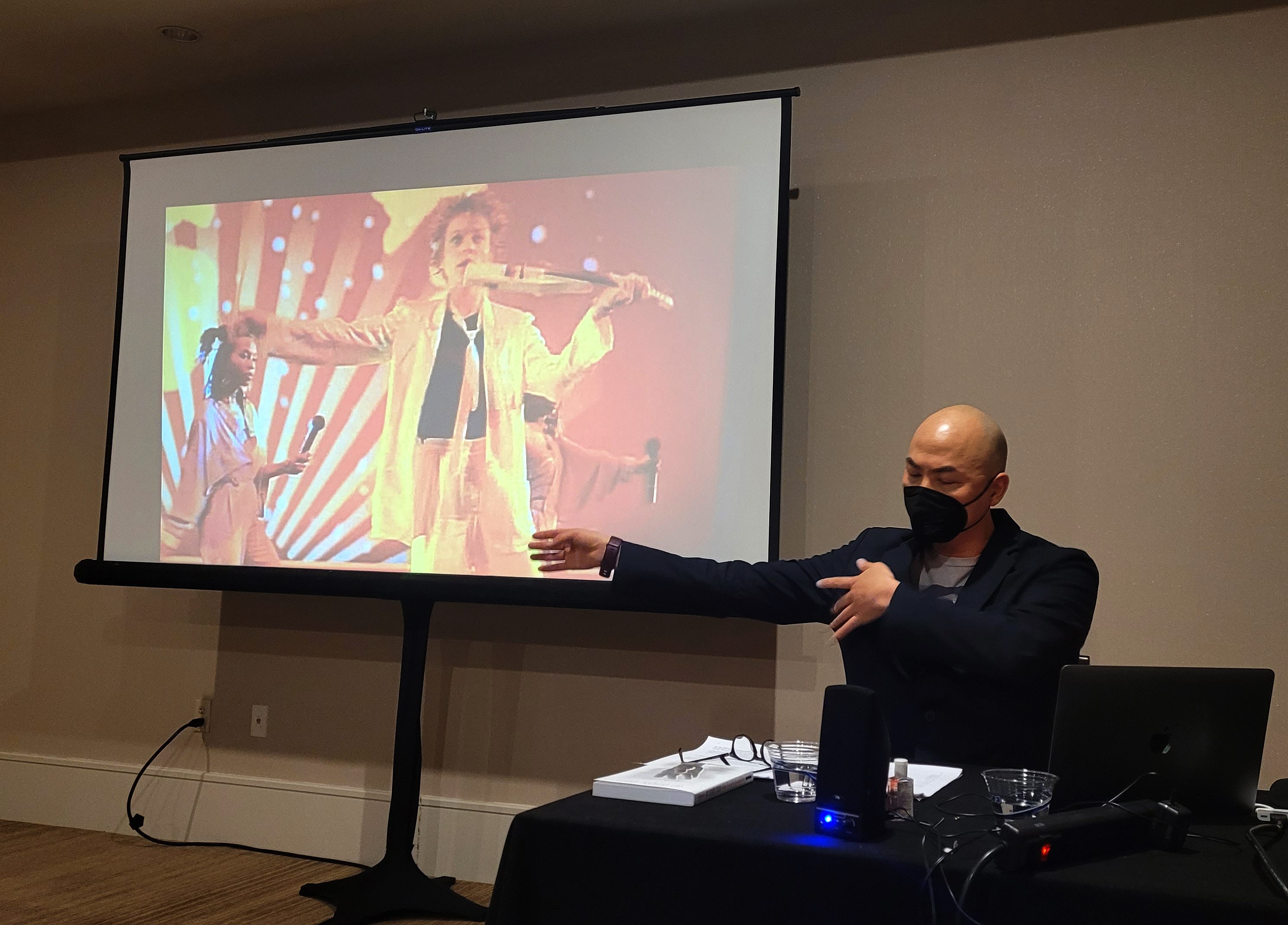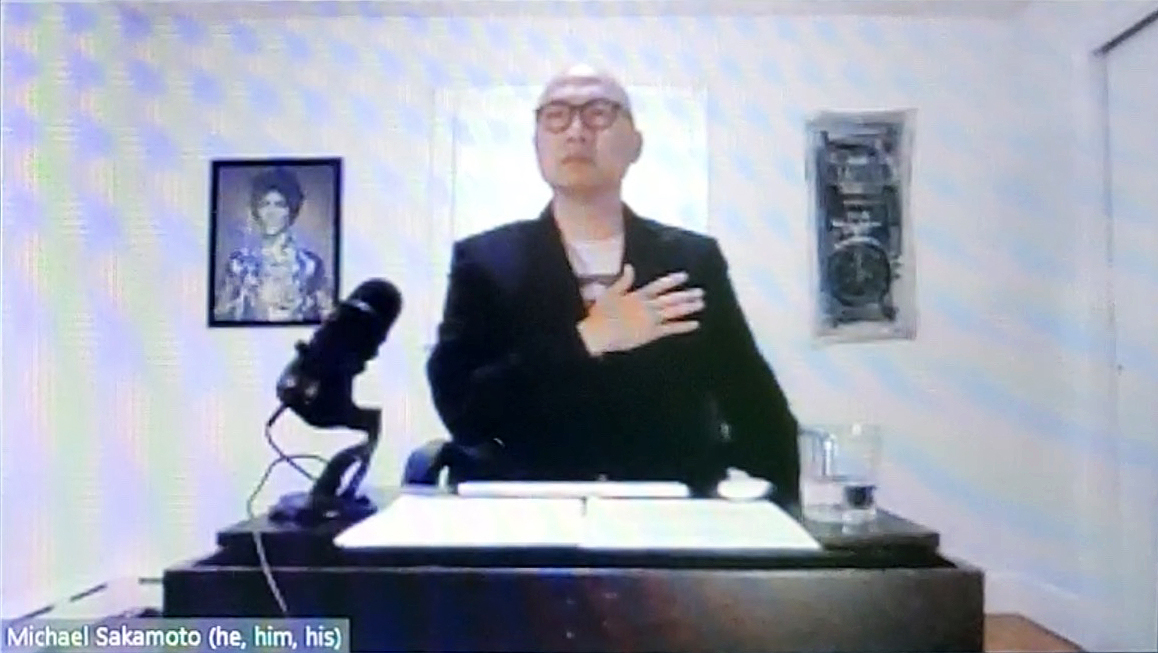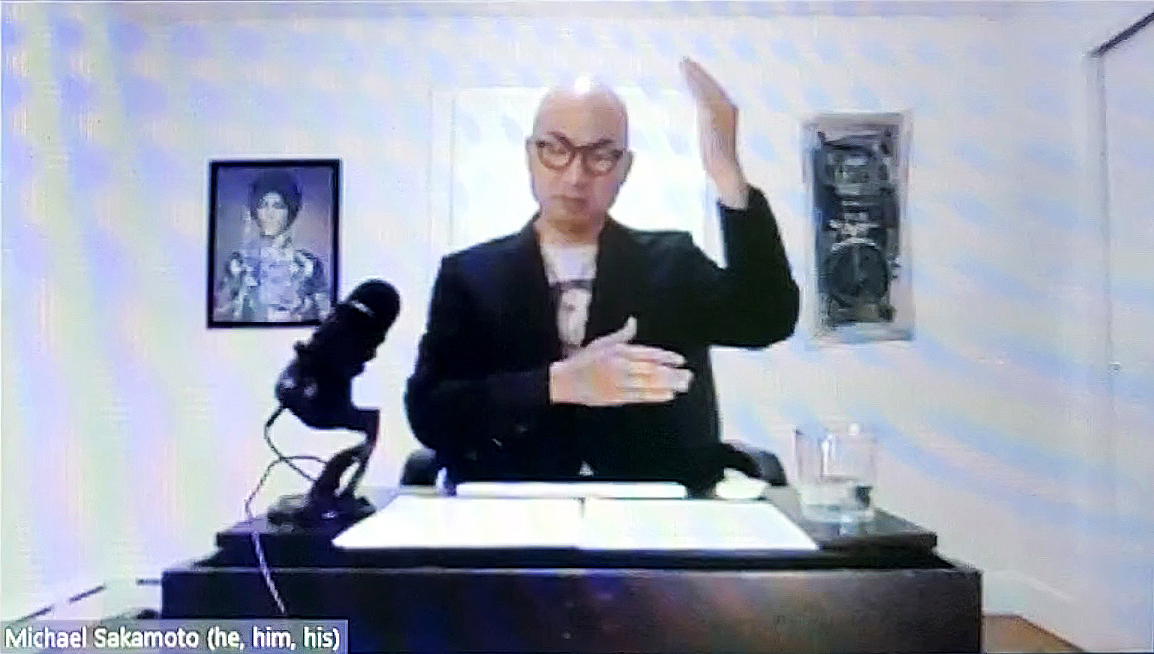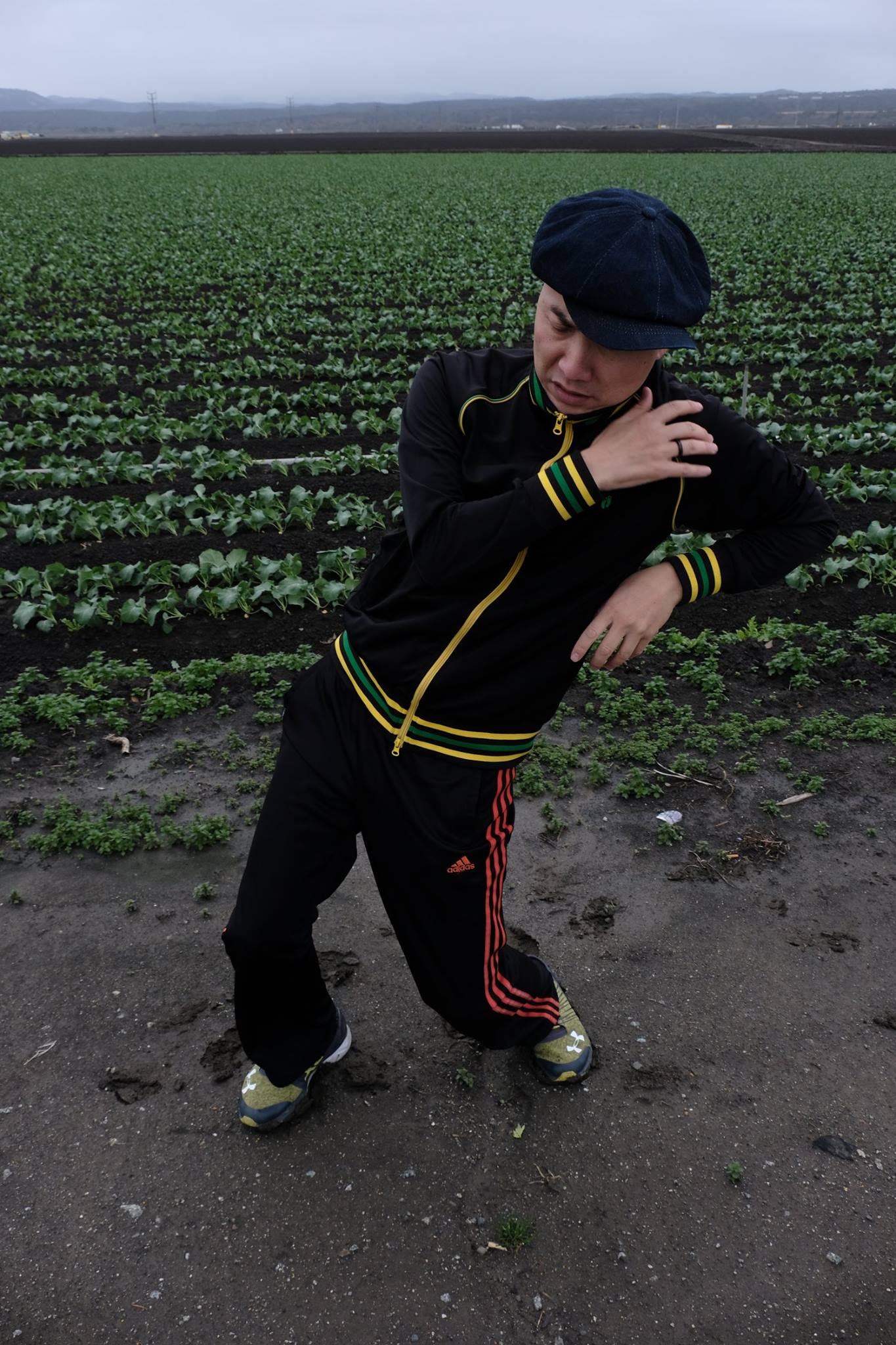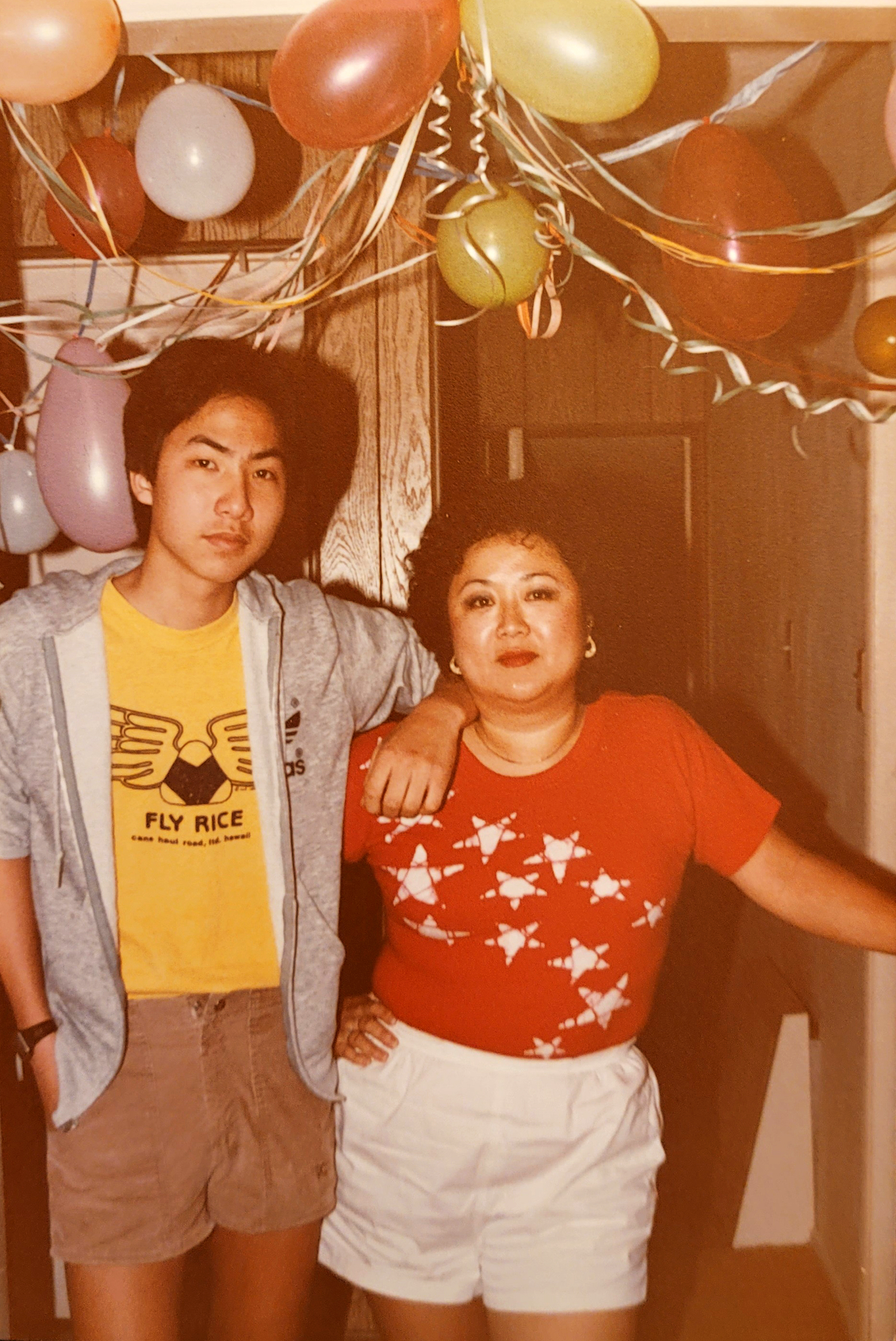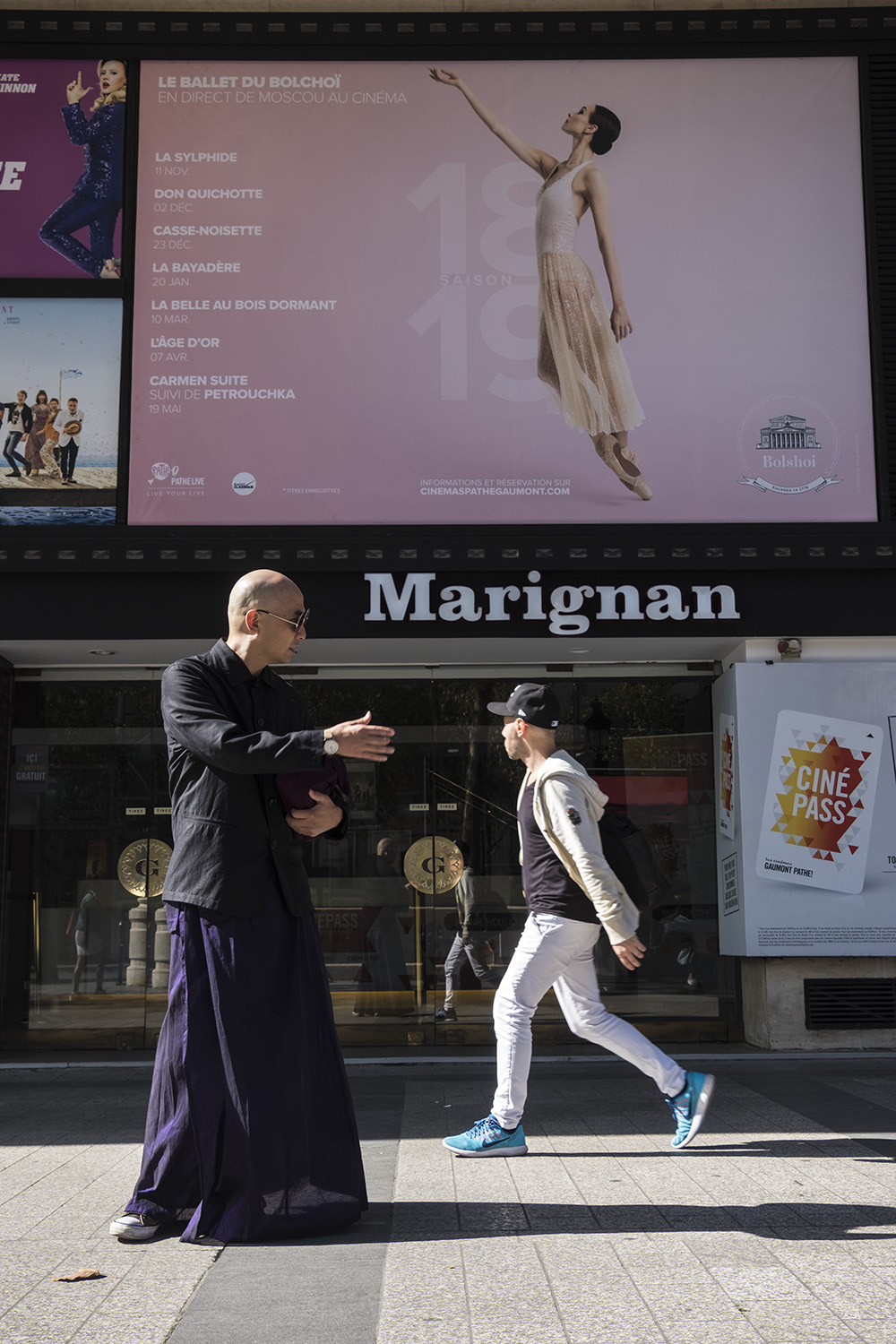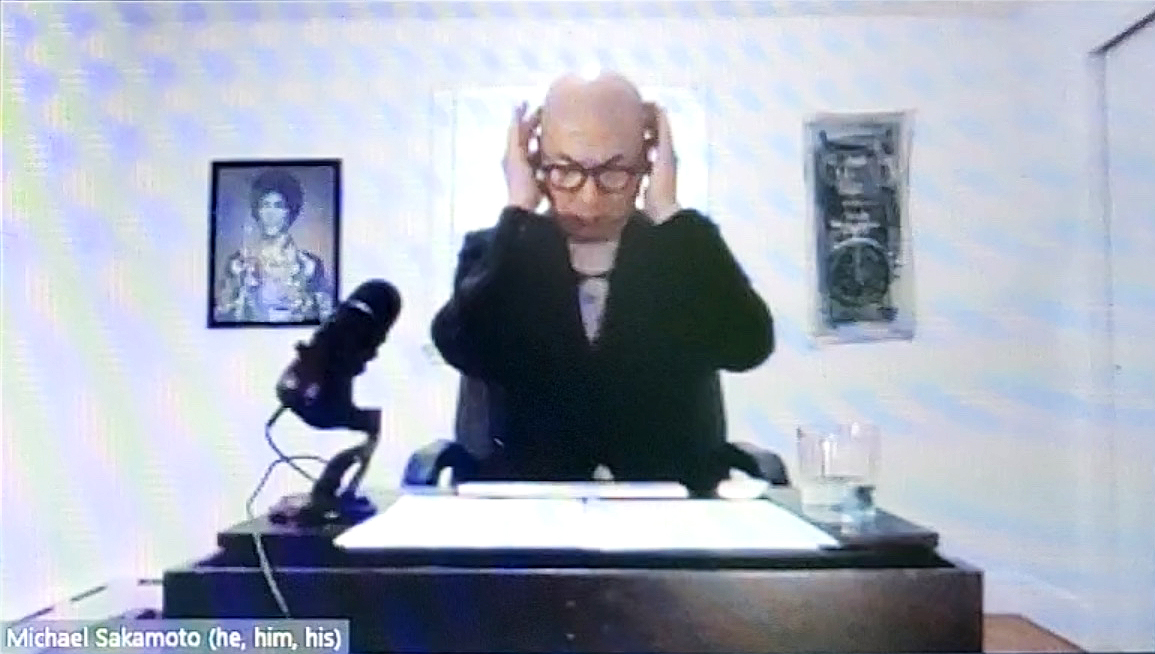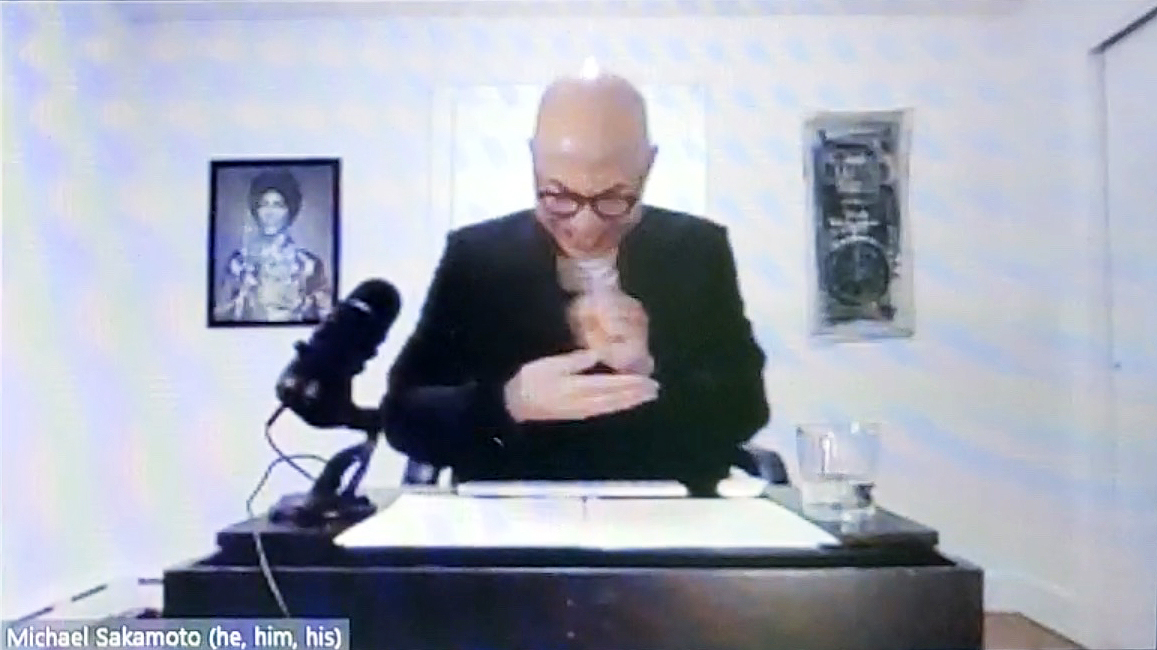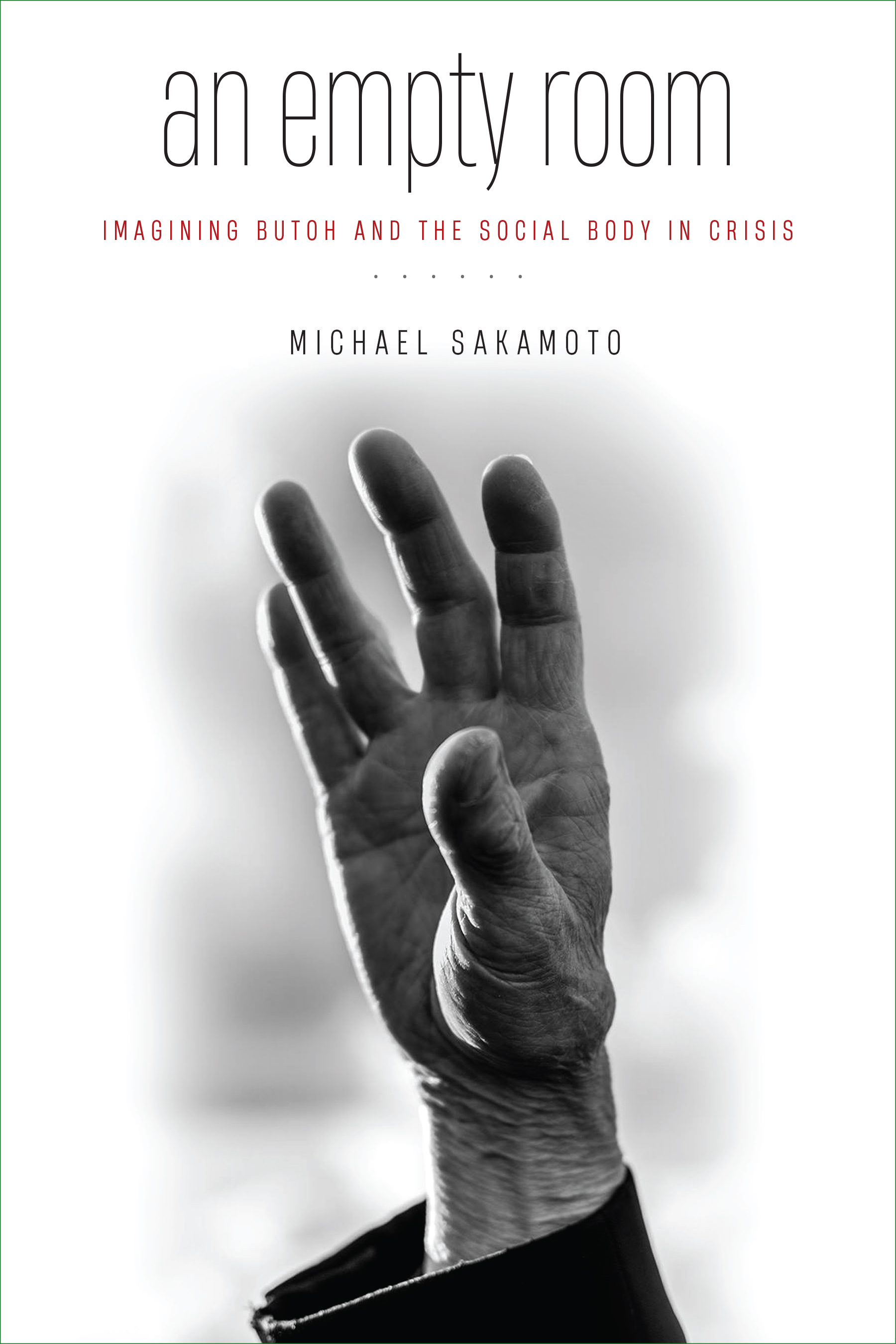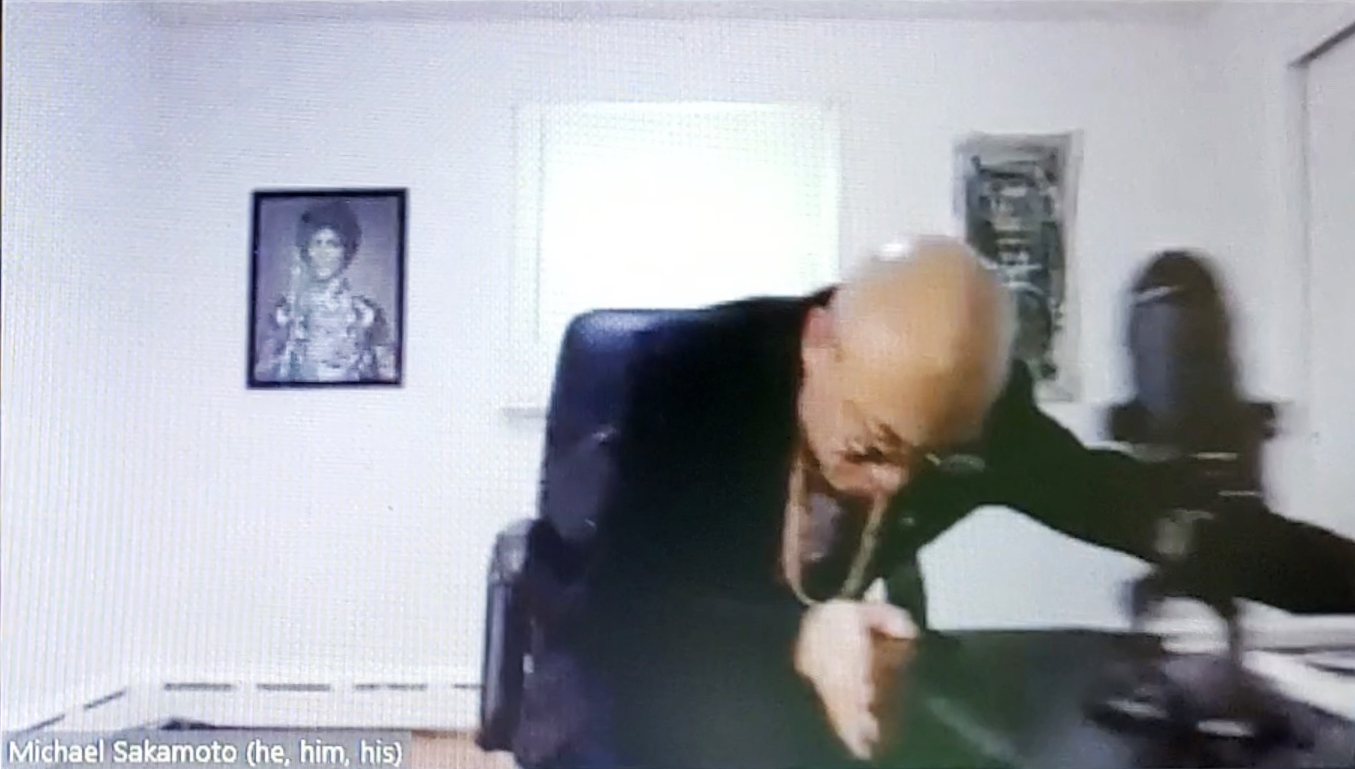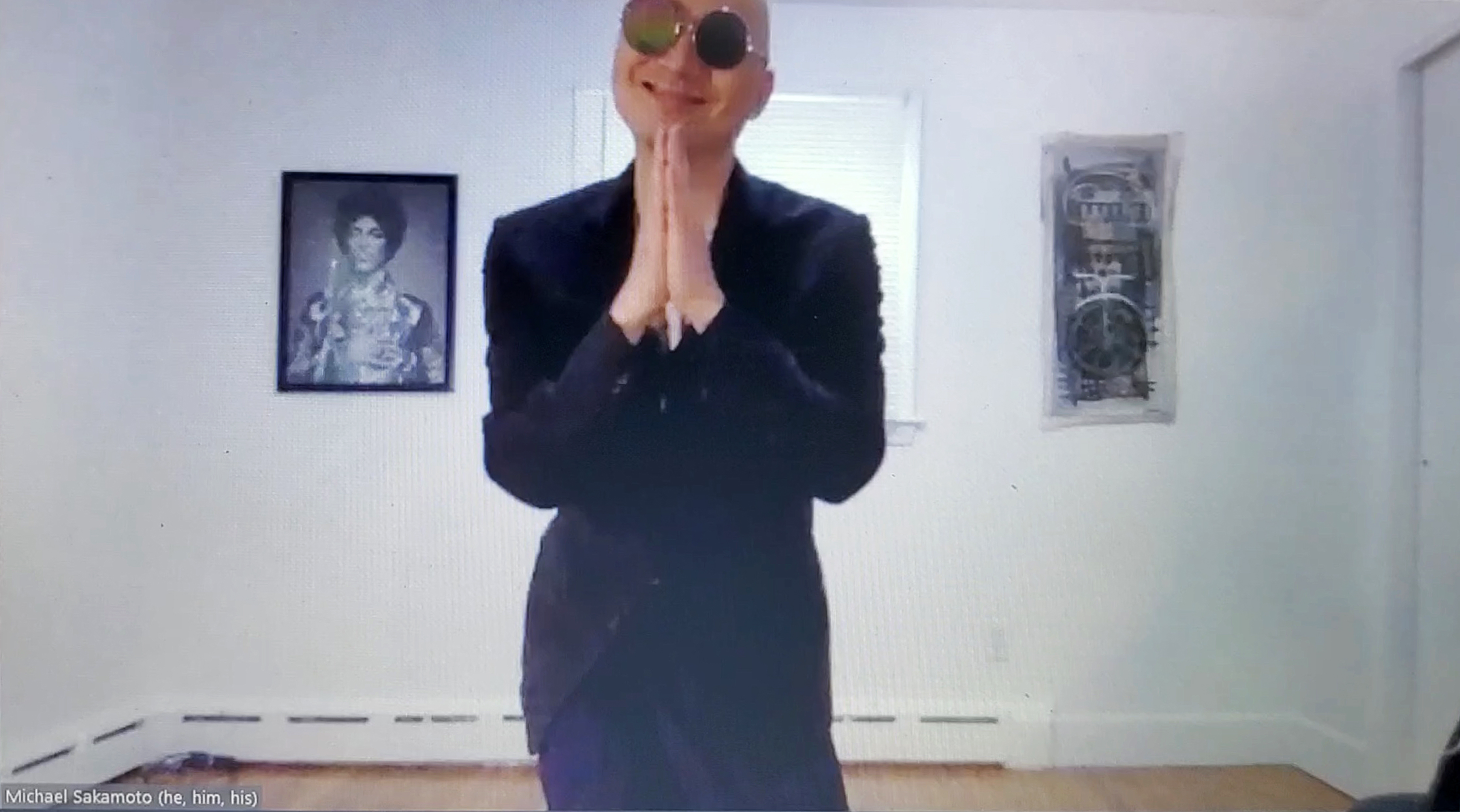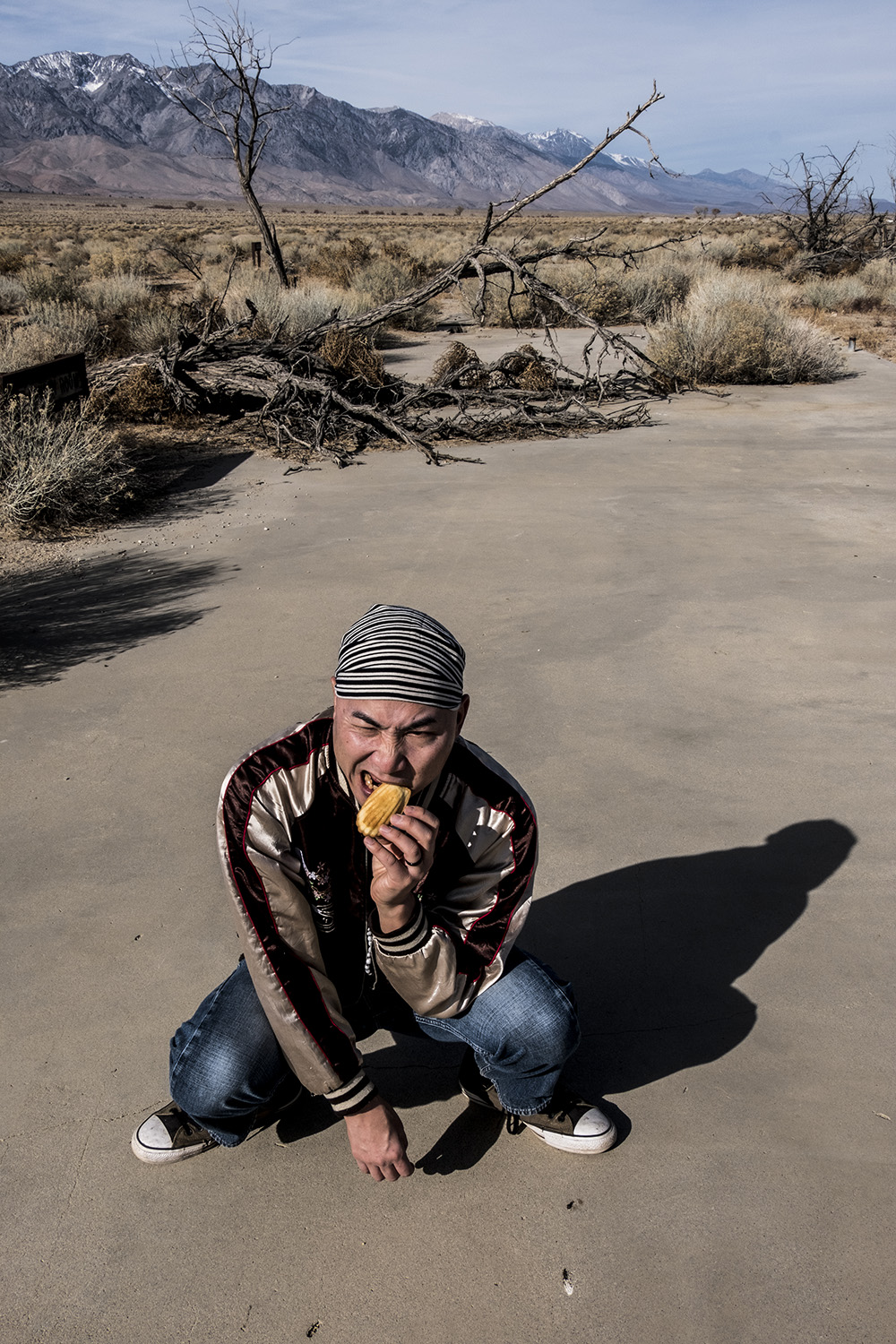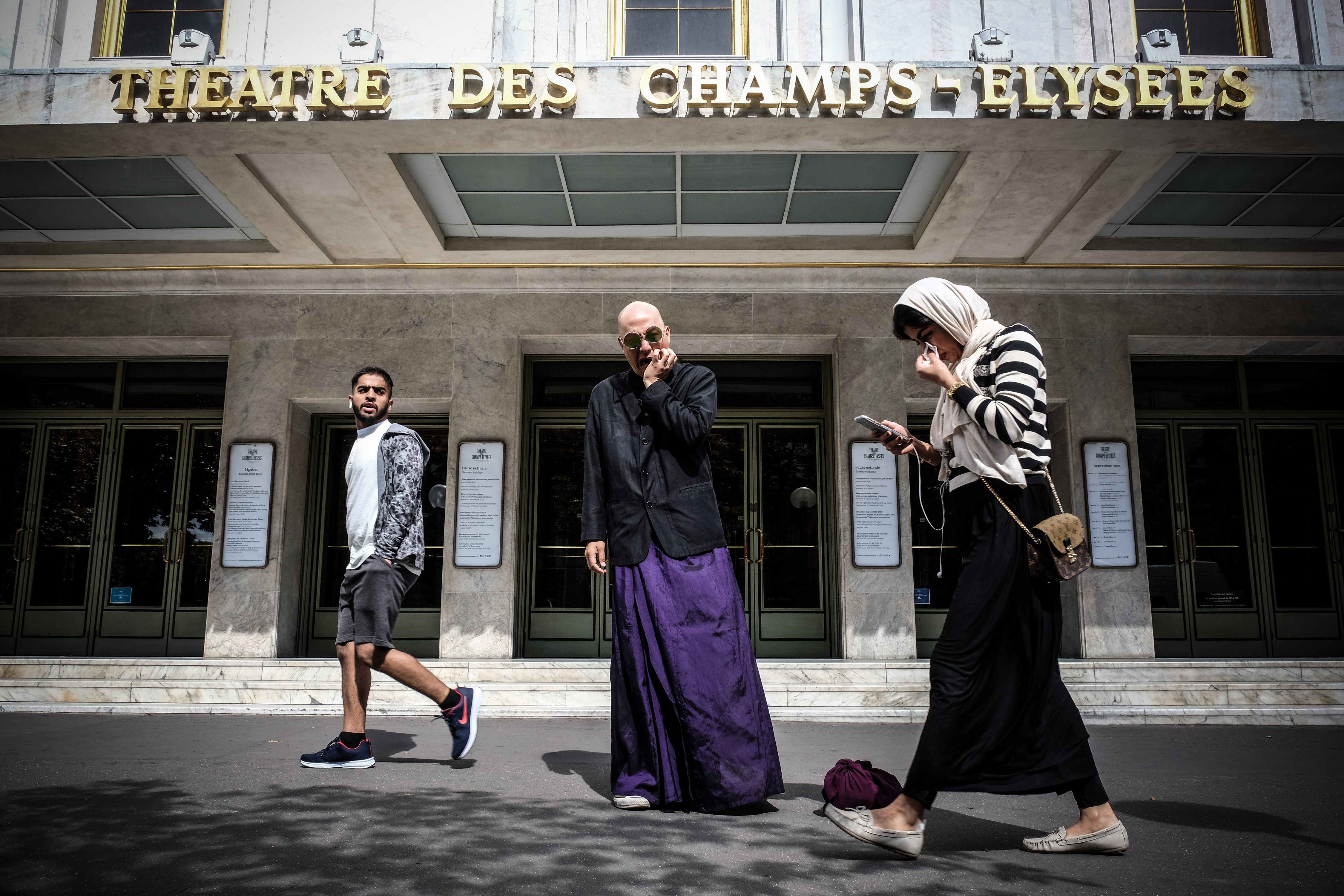[This script is based on a lecture-performance presented in multiple forums since 2021, and revised for this issue. The final text has been redacted due to legal threats and attempts to intervene in the editorial process by . All persons and institutions have remained anonymous in all versions of the text and performance to date. did not have access to the text prior to publication.]
SLIDE:
Slideshow of images from Michael’s MuNK performance photo series set in Japan, Hawai’i, California, and Paris.
Michael enters, dressed in a Japanese bomber jacket, jeans, sneakers, and baseball cap. He sits down at a table with a printed script, microphone, glass of water, and Japanese meditation bell. He bows and rings the bell three times.
The University fight song plays.
SLIDE:
Oxford English Dictionary: “The definitive record of the English language.”1
The definitive source for the following terms.
(Words slowly fade.)
Michael removes his cap, changes to a suit jacket, sips water, and stares at the audience. As music ends, Michael smiles.
SLIDE:
Forebear: An ancestor, forefather, progenitor.
(Words slowly fade.)
Michael:
After starting a tenure-track, university faculty position as a specialist in non-Western dance, interdisciplinary performance, and media, I attend a reception for faculty of color sponsored by the diversity office. In the White male Provost’s remarks, he reminds us that we should never forget the sacrifices that generations of our forebears made. As he shakes a couple hands, eats some hors d’oeuvres, and leaves, I think, who is he to tell us the thing about … the thing … we already… ?
But then I think, hey, thanks, Mr. Provost, because at least you reminded me, right?
SLIDE:
Montage of early Japanese laborers in the USA.
Michael:
Not just about my obvious forebears, like my immigrant labor ancestors who built Hawaiian plantations and worked California farms, volunteered out of the camps that imprisoned my entire family to die rescuing trapped Texans in Italy and Holocaust victims in Germany, established the first legal precedent in US history for reparations for racial discrimination, or others you might’ve googled before you spoke.
I’m thinking also of our less obvious predecessors. Like, so not obvious, they’re assumed. Because like all of us, they’re just … there … around … all the time.
SLIDE:
Uppity: Above oneself, self-important, jumped-up; arrogant, haughty, pert, putting on airs.
(Words slowly fade.)
Michael:
In my first year, I premiere an evening-length work with one of the country’s leading hip-hop choreographers for concert dance, receive a book contract with the same press with which my department’s only other scholar published ahead of tenure, publish in two journals, produce a dance film, and win a major national dance production grant for a second evening-length performance. With the above in mind, while getting advice from a White ombudsperson on navigating University culture, I ask about the prospect of going up for tenure early if my success continues. She says it won’t work, that even if I deserve it, I’ll be seen as “not behaving” in the University culture.
She says I’ll be considered “uppity.”
“…Excuse me?”
She asks, “You’re familiar with Asians, right?”
“…Uhm … Yeah… (?)”
“Well, think of it this way,” she says. “You’re surrounded by White people who act like Asians: knowing your place, not complaining, staying in your lane.”
Michael stares at the audience for a beat.
Michael:
…Truth is, as a young, aspirational, Asian American artist, I’d thought about these things—Who am I to complain? What is my place? Where is my lane?—starting as a college art student looking for inspiration; for successful artists after whom I could model myself.
SLIDE:
Film still from Swimming to Cambodia (Demme 1987).
Michael:
For example, when I was 19, performance artist Spalding Gray taught me self-confidence with the film release of his monologue play, Swimming to Cambodia. As an only child who’d spent years alone with my thoughts, it blew my mind seeing an actor sitting alone, talking about himself for an hour and a half, and most of all, being taken seriously by countless theater and movie audiences. Maybe I too could make a living someday by becoming a performing artist, going around the world, writing about the experience, and parading my feelings on stage for others. So I became obsessed with figuring out, How did he do all this? And years later, I realized … it’s easy.
On the surface, Swimming to Cambodia is simply Gray’s story about working in Thailand as an actor on the film, The Killing Fields. However, because he steadfastly holds to his personal and cultural beliefs in the face of war, racism, and genocide, it’s also a lesson in staying true to yourself.
(gradually voicing a louder, more insistent, and vaguely Spalding-like accent)
Swimming to Cambodia is a master class in keeping the audience so distracted that they experience the performance as art, yet amused enough that they also experience it as entertainment and walk away satisfied with the fact that Gray still to that day knew almost nothing about Cambodians, not the least reason for which being he only worked in Thailand and never went to Cambodia, because, as he said, trying to understand that country and its people was, like swimming there, impossible.
As a simultaneously modernist and postmodernist White male hero, Gray is following in the tradition of garnering praise by claiming knowledge of a subject through claiming no knowledge of that subject. Just like he can’t understand the Thai bargirls and sex workers that he prefers 11 times in his show to call “whores,” nor can he understand the Khmer Rouge genocide because “we” don’t speak Cambodian, unlike the fact that “we” can understand what happened in Germany because “we” speak German (Gray 1985: 51).
In other words, for a White guy on the loose in Southeast Asia, life is hard.
SLIDE:
Color: The hue of a person’s skin, typically of the face, esp. as reflecting or indicating physical health or emotional state; a person’s complexion.
(Words slowly fade.)
Michael:
In naming the head of my contract review committee, my White assigns a full Professor who has repeatedly proclaimed, “I don’t see color.” Given that most of my teaching and all my research is centered on ethnicity, race, and culture, I express concern that they may have a conflict of interest, and request a change. acknowledges my concerns and that their opinions are difficult to hear, but hands the decision to the , who sees no issue and denies my request.
Later, in a faculty meeting, expresses indifference towards race and culture in the curriculum. They say that they make teaching more difficult and “go over my head.”
At the same time, I am assigned to teach a course on race and culture in dance for the third consecutive semester out of an eventual five.
SLIDE:
Film still from Home of the Brave (Anderson 1986).
Michael:
Another film that I saw as a young artist was Home of the Brave, by another White New York artist, Laurie Anderson, whom you’d already know, of course, if you had seen Swimming to Cambodia, because Spalding Gray drops her name along with other cool White New York artists without any context, because of course you already know who they are.
Anyway, Laurie Anderson taught me the privilege of dancing as I please and speaking with multiple voices. I was amazed that someone had created a multimedia concert, avant-garde performance, and full-length film all at once. She even tore apart a Linn drum machine, strung the pads all over her body, and performed awkward but beautifully evocative dances for her songs. She did it all, and I was so inspired, that for years, I wanted to be Laurie Anderson…
(Gradually voicing a halting, Laurie-type speech pattern)
A whole career where you get to perform as “yourself,” and speak in witty phrases about whatever you want, as long as the audience believes some central truth about you, like a wise old master or monk holding forth, except through the body and voice of a White female.
And sometimes she would use technology to make that voice more masculine, or artificial, so that you would know it was her and not her.
And somehow, I was attracted to that. Somehow, as an Asian American, it all felt familiar. Being able, or expected, to perform simultaneously as me and not me…
Audio plays of Michael with a Laurie Anderson-style, synthesized voice and a Linn drum machine musical sequence as he performs a dance of embodied contradiction.
Michael (VO):2
And then a Korean musician tells a story, saying “we,” as if he’s Japanese, except he’s Korean, dressed in Korean clothes, so …
And her Black backup singers sing in Japanese. One is waving a big oriental fan, and the other wearing a big oriental costume sleeve.
And William S. Burroughs says, “Hey, Kimosabe. Long time, no see.”
And her White guitarist comes on stage in a sombrero.
And she sings, “Hey, Kimosabe! Long time, no see!”
But I’m young, and I’m not thinking deeply about these things, and it’s the 80s, and everything’s clever and bright…
So I buy her next album, which ends with a misty ballad, Hiawatha, riffing on Longfellow, mythic Americana, the dream…
And I think to myself, that’s not me and … not me…
And 20 years later, I think to myself, it’s certainly not Hiawatha…
But I don’t know that now, back then…
So I keep that cassette in my car, just driving along, for years…
And then another album, with another song, Night in Baghdad, satirizing an American reporter’s first world problems while reifying his invisibilization of the murder of hundreds of Iraqi civilians, and I think to myself, there’s something wrong here, but I don’t know what it is…
But then I see she’s written a book about her art adventures, and then she takes on the biggest book of all: the great American novel, Moby Dick, with a great big multimedia show, and a multi-talented cast…
And I say to myself, that’s it! It’s still not me and not me, but I could make it me. I’m in an internationally touring contemporary theater company now. I’m a butoh artist creating original works now. I can dance. I can speak. And most of all, I’m American!
All I have to do now is write a book…
SLIDE:
Parochial: figurative. Relating or confined to a narrow area or region, as if within the borders of one’s own parish; limited or provincial in outlook or scope.
(Words slowly fade.)
Michael:
In a meeting with the to discuss my teaching, states, without examples, that I have a “limited” understanding of “interdisciplinary and cross-cultural” research, that I operate from “a very parochial perspective” and work “to legitimate that parochial perspective,” and I need to broaden my appeal to “many different audiences.”
Up to that point, my research consists of national and international publications, exhibited photography and film, and public performances in multiple venue formats, languages, and countries, all engaging Asian, Asian American, African American, and Western cultural vernaculars that I’ve been studying and practicing for three decades.
I don’t know. Maybe I should’ve just trusted that they had my best interests in mind. Like later when told me I needed to publish a book for tenure, despite my contract, which they helped draft, explicitly not requiring it and allowing for seven distinct multidisciplinary and intercultural modes of tenure accrual. I guess they just knew what the university liked to see, versus what they actually hired me to do.
I mean, sometimes you just know what you like, right? Like my favorite song. I mean, it’s really my favorite. The kind of song you can’t live without because the first time you heard it, it told you who you were; maybe even who you’ve always been.
The opening bars of “If I Was Your Girlfriend” play.
Michael:
In March 1987, Prince’s Sign o’ the Times album came out, with twists on all the standard genres—party anthem, protest song, love song, breakup song, even a children’s sing-along—but one track that took my breath away: “If I Was Your Girlfriend.”
Somehow, for a skinny, Asian American, 19 year-old male navigating Ronald Reagan’s newly aspirational version of American hyper-masculinity, this song by a 5′3″, Black male musician in falsetto, four-inch heels, and eyeliner stretching from the Mississippi to Lake Minnetonka not only taught me how to be in love, but captured the simple feeling of what it meant to be me. Perhaps ironically, as the only child son of a single mother, I’ve always been a romantic. Having witnessed heartbreak growing up, I’ve always aspired to be “that guy,” who always wants to save the day, and would do anything to make it happen.
I have other favorites. Food, ramen. Sport, basketball. But a favorite song is special. It’s a spirit in audible form. It can capture your heart and make you wanna do things, like take up a new hobby, fall in love with a person or place, or maybe even aspire to a new career.
So later, as an academic discussing aspiration, I understood quite well.
SLIDE:
Aspire:To breathe desire towards. intransitive. To have a fixed desire, longing, or ambition for something at present above one; to seek to attain, to pant, long.
(Words slowly fade.)
Michael:
In one faculty meeting, for example, we discuss our accreditation being delayed due to numerous perceived discrepancies in our program. says it would help our case to claim a global dance technique curriculum, despite the departure of the only two faculty who taught it. In response to another faculty of color and me pointing out that this would be a false claim, they say that the fact that “we aspire” to such curriculum is enough.
We ask if that’s like the two of us aspiring to be White.
No one responds.
They change the subject.
The opening bars of “Diabaram” by Ryuichi Sakamoto and Yousou N’Dour play.
Michael:
I learned humility and how to work with others on their own terms from Sakamoto Ryuichi, or, as Westerners call him, Ryuichi Sakamoto, perhaps because to them, family comes last and individuality first. What came first in Sakamoto’s music, however, and without fanfare or spectacle, were the underlying cultures of his collaborators, especially the many African and African American singers and musicians whom he featured on record and on tour. And when I saw him in concert in 1990, the audience clamored for an encore at the end of the show. After some minutes, he sheepishly returned.
SLIDE:
Video stills from Sakamoto Ryuichi concert post-show in London, 1990.
As a few moments of Sakamoto speaking plays, Michael desperately attempts to dance butoh funk/popping style while remaining seated.
Ryuichi Sakamoto (VO):
Hello… . Well, I was a bit upset because you didn’t dance, so I thought you didn’t like me… . I guess you like me… . Are you enjoying? (Audience cheers.)
Phew. Okay.
SLIDE:
Like:To please. To take pleasure in or be pleased by something. To be in a favourable condition.
(Words slowly fade.)
Michael:
Growing up, I was told by older folks in my community that in order to succeed, I needed protective coloring. I needed to appear as something White people wanted. I needed them to like me. So for decades, regardless of my Spalding-like self-confidence, Laurie-like intercultural privilege, Prince-like independent streak, or Ryuichi-like quietude, I have always, in every moment, thought about how I’m seen. So in the midst of my performance review, I ask numerous BIPOC colleagues about my situation.
One says it is not good to defend myself in writing.
Another advises that I should convince my chair that they can “collect” me.
While standing in an outdoor parking lot with no one else in sight, another whispers that I should sue the University for harassment.
Another reminds me how lucky I am to have a job.
A White male colleague says if he were being treated the way I was, he’d be yelling and upending tables at faculty meetings. He later rescinds his offer to write me a letter of support because he’s afraid for his job.
A White female colleague recently granted tenure tells me she is disgusted by the system, which favors White mediocrity. “It’s not easy, but I see how much less difficult it is for me than for you. How I’m not perceived as a threat.”
SLIDE:
Crazy: Of unsound mind; insane, mad, demented, ‘cracked’. Often used by way of exaggeration in sense: Distracted or ‘mad’ with excitement, vehement desire, perplexity, etc.
(Words slowly fade.)
Michael:
I also discover similar stories throughout the institution. A Latinx faculty told not to refer to himself as a professor. A White department chair grossly and repeatedly mispronouncing the simple two-syllable name of an Afro-Latin graduate student and world-class professional. Senior faculty voting against a Latinx junior faculty with more research and a national award-winning book. Three consecutive Assistant Professors in one department, all POC or female, voted down for renewal or tenure. The list goes on.
Meanwhile, in my performance review, dozens of allegations are made against me based on mistaken names and dates, missing research and course credits, omitted student evaluation scores, miscalculated enrollments, over a dozen factual errors by the faculty dean, and the eventually false assertion that “it is hard to imagine” that I will make my book manuscript dead-line.
I meet with an Asian dean who has publicly spoken on their own experiences with racism and ask if I’m doing something wrong. For an hour, they shake their head emphatically, and say, “You’re right. You’re not crazy.” They then say my department and I are just “a bad fit,” that I should leave the University, and there’s nothing they can do. I remind them that the Deans are obligated by law to vet my review. They shrug and silently walk me out of their office.
I meet with the chief diversity officer, who agrees my treatment is racially biased and offers to help me work with a high-profile campus leader to publicly legitimize my work and a respected senior faculty of color to mentor me on navigating the University’s toxic space. They then neglect to return any of my emails and phone calls and leave for another job.
The opening bars of “New Position” by Prince play.
SLIDE:
Interdisciplinary: Of or pertaining to two or more disciplines or branches of learning; contributing to or benefiting from two or more disciplines.
(Words slowly fade out.)
Michael:
After three years as Assistant Professor, I have published on Cambodian, Thai, Vietnamese, Filipino, African American, Japanese American, and Western postmodern dance artists in six academic journals and book anthologies; completed a contracted book manuscript on transnational butoh; created and/or presented four dance theater performances, two photo essays, and a film in over a dozen national and international venues; all amounting to significantly more research than most of my senior colleagues in the same period of their tenure track. I’ve designed and taught six different lecture, discussion, practicum and lab courses for graduate students from five departments and general education undergraduates, served on two search committees, a curriculum committee, four MFA committees, and a PhD committee, and contributed to my department’s recertification process.
Around the same time, the faculty dean grants the department a “new” Assistant Professor position. During a faculty meeting, states excitedly, while I’m seated next to them, how special and amazing that the line is “interdisciplinary” because “we’ve never had anyone like that.”
The room goes silent, all eyes faced down.
They change the subject.
A White postmodern dancer is later hired into the new position.
That same year, the university schedules an in-person workshop for White staff, faculty, and students to learn about their privilege and take greater responsibility for racism on campus, and then abruptly cancels the workshop because the subject might cause “confusion,” “concerns,” and “misperceptions.”
The workshop is then rescheduled after the school year is over.
That summer—for many reasons—I leave for a position at another institution.
SLIDE:
“If you wish to dance a flower, you can mime it and it will be everyone’s flower, banal and uninteresting; but if you place the beauty of that flower and the emotions which are evoked by it into your dead body, then the flower you create will be true and unique.”—Ohno Kazuo (Viala and Masson-Sekine 1988: 23)
As a Linn drum funk beat plays over Michael’s synthesized androgynous voice, Michael dons a long skirt and dances to deconstruct and recode his internalized constructs of Whiteness in front of projected images of himself from his MuNK photo series.
Michael (VO):
Look at the bargain over here, ladies
Ooh, oh.
Ooh, hoo, oh yeah.
Ooh, hoo.
If I was your girlfriend, would you remember
To tell me all the things you forgot when I was your boy?
Hey hey, when I was your boy.
If I was your new friend, would you let me
Take care of you
And do all the things that only a new hire can?
Oh, only new hires can.
If I was your girlfriend.
Ooh, hoo, ho ooh.
If I was your girlfriend.
If I was your girlfriend, would I let you vet me?
I mean, help you pick out my words before I speak out?
Not that you’re racist,
But sometime, sometime those are the things
That an annual review’s about.
If I was your one and only friend,
Would you run to me if somebody questioned your ideology,
Even if that somebody was me?
Yeah, ee hee.
Sometimes I trip on how real we could be.
Plee-hee-hee-hease.
If I was your girlfriend.
Ooh, hoo, hoo.
If I was your girlfriend.
Would you let me proof your book?
Could I cover your class sometime?
Well then, could we just hang out?
I mean, could we go to the dean’s lecture and sit together?
‘Cause, to me, baby, that would look so fine, ooh.
Baby, can you vet me?
I mean, help me pick out my words before I speak out?
Listen here, I ain’t sayin you’re racist,
But sometime, sometime those are the things
that a performance review’s about.
Sugar, do you know what it’s saying to you in my contract?
Maybe you want me to appear self-centered,
But I, I said I just want to be
All of the things I’m supposed to be.
Surely, a general counsel could see.
Is it really necessary for me to go out of the room
Just because you want to discuss me?
We don’t have to make tenure to make research.
And we don’t have to do positivism to experience new knowledge.
Your lazy sabbatical’s what I’m all about.
Can I see it?
I’ll show you my Asian immigrant work ethic.
Why not?
You can do it because you made me your friend.
I have to do it for you.
Of course I perform my race in front of you.
And when I become White, what shall I do?
You’re the one who made me see that it’s cool.
Can’t you just use me?
If I was your girlfriend, you could.
Oh yeah, you know so.
Listen, for your Whiteness, I would dance a ballet.
Would that get you off?
Tell me what will.
If I was your girlfriend, would you tell me?
Would you let me see your Whiteness then?
Would you let me introduce your talk?
Would you let me cite you so hard you’d laugh and laugh,
And would you, would you let me quote you there,
You know, down there where it counts,
I’ll do it so good,
I swear I’ll drink every ounce of your Kool-Aid.
And then I’ll quote you tight and quote you long
And together we’ll perpetuate the silence…
And we’ll try to imagine what it looks like.
Yeah, we’ll try to imagine what, what teaching looks like.
Yeah, we’ll, we’ll try to imagine what service looks like.
Yeah, we’ll try…
Michael falls flat on the ground. After a few moments, he rises, changes back to his Japanese bomber jacket, jeans, and baseball cap, and sits down at the table.
Michael:
Months after resigning my tenure-track position, as I’m greeting audience members in my new role as director of performing arts programming and Asian and Asian American arts and culture at another PWI university, an elderly White woman and longtime patron tells me about a beautiful dancer she’s recently seen who moves so small and passive, and in cute tiny steps, “You know. Like a Japanese,” and repeats her statement for emphasis. I stare back.
After the encounter, my White colleague, who introduced me to the woman, apologizes. “That was so racist. I’m so sorry you had to endure that,” she says, without explaining why she didn’t say anything.
As I step away to introduce the concert, I shrug. “It’s five minutes to curtain, and I’ve been doing this for 30 years. There are some things I just don’t have time for.”
And most recently, has begun writing on dance and photography … in Japanese American prison camps.
Michael rings the bell once, stands, bows, and exits.
Notes
- Oxford English Dictionary, accessed June 27, 2022, https://www.oed.com. ⮭
- VO is an acronym for voice-over. ⮭
Author Biography
Michael Sakamoto is an artist, scholar, educator, and curator in dance, theatre, photography, and media art. His creative works have been presented globally in 15 countries, including at Dance Center of Columbia College–Chicago, Vancouver International Dance Festival, REDCAT, TACTFest Osaka, and other venues. His recent works include Flash, a butoh/hip-hop collaboration with Rennie Harris; the dance theater trio, Soil, featuring Thai, Vietnamese, and Cambodian performers; blind spot, an intermedia performance with digital musician Christopher Jette; and the transnational butoh solo, Nikkei-Chan. His work in development includes Garden of the Wilis, with dance and theatre artist George de la Peña, violinist Hyeyung Sol Yoon, and co-director/dramaturg Asher Hartman. Sakamoto’s scholarship appears regularly in journals and anthologies in numerous disciplines, including from Routledge, Palgrave MacMillan, Thames and Hudson, and others. His book monograph An Empty Room: Imagining Butoh and the Social Body in Crisis, a critical autoethnography of Sakamoto’s three-decade journey through butoh history, practice, and theory, was released in spring 2022 by Wesleyan University Press. Sakamoto is former faculty at California Institute of the Arts, Goddard College, Bangkok University, and . He currently serves as Director of Asian and Asian American Arts and Culture and Performing Arts Curator for the University of Massachusetts–Amherst Fine Arts Center.
Works Cited
Anderson, Laurie, director. Home of the Brave. Cinecom Pictures, 1986.90 min.
Demme, Jonathan, director. Swimming to Cambodia. Cinecom Pictures, 1987.85 min.
Gray, Spalding. Swimming to Cambodia. New York: Theatre Communications Group, 1985.
Nelson, Prince Rogers. Sign o’ the Times. Paisley Park/Warner Brothers Records, 1987. Vinyl LP.
Viala, Jean and Nourit Masson-Sekine. Butoh: Shades of Darkness. Tokyo: Shufunomoto Co., 1988.
